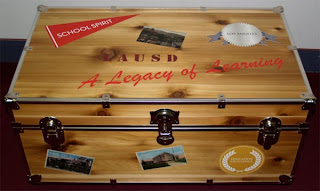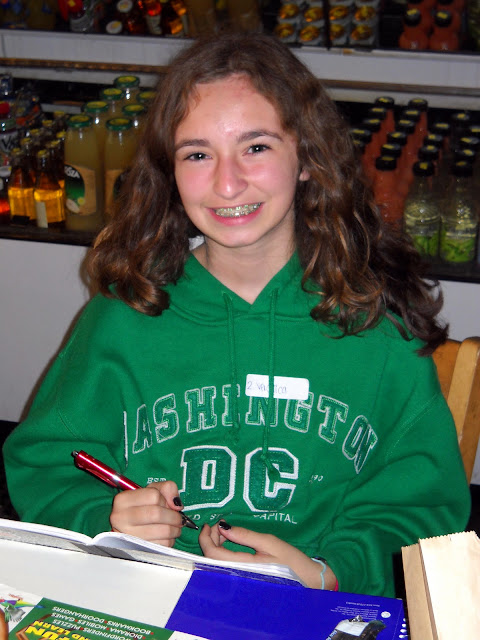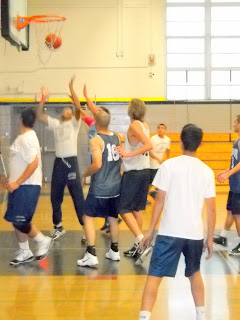 |
| Famed Artist Maynard Dixon's Men of the Red Earth, worth an estimated $2 million owned by the Los Angeles Unified School District |
 |
| Leslie Fischer views some of the collection she's in charge of. |
 |
| LAUSD curator Leslie Fischer puts together a collection of items used to teach LAUSD students about the history of their predecessors. |
 |
| Roman coin discovered in the collection along with the Greek Vase below. |
LOS ANGELES UNIFIED SITS ON DONATED ART WORKS WORTH MILLIONS; SOME ARE IN SCHOOLS GOING UNNOTICED, OTHERS ARE LOCKED UP IN A CLIMATE CONTROLLED DOWNTOWN SCHOOL POLICE BUILDING;
ONE PERSON’S MISSION : TO MAKE THE COLLECTION WORKABLE FOR EDUCATION AND TO BRING IT TO THE PUBLIC EYE
By Diana L. Chapman
Several years ago, Leslie Fischer was sent downtown Los Angeles to clear out a small, locked space laced in mystery.
The curator opened the door and peered inside, spotting scores of items bundled in newspapers. What she was about to discover shocked her.
As she unfolded the bundles, out popped one antiquity after another, 300 in all; Relics such as Roman coins, Greek vases, Etruscan figurines, Egyptian scarabs. Those were just some of the gems. They all belonged to the Los Angeles Unified School District. “It was really flooring,” said Fischer of the antiquities find during an interview at one school that has a vault to secure its paintings. “I wasn’t even aware of the scope of what they had. The storage was so inappropriate. It was surprising. How did the district get this and why is it here?” Fischer – whose very part-time LAUSD curator job always hangs by a thread in these severe economic times – is the only person in the entire district who holds the golden key to Los Angeles Unified’s 100,000 piece art and artifact kingdom. She’s on a new mission to bring the obscure collection out to the public eye and to form several educational partnerships. The collection boasts phenomenal pieces such as oil paintings from famous artist Maynard Dixon and rare books as the 1602 edition of “Works of Our Ancient and Learned English Poet, Geoffrey Chaucer.” In addition, the works include thousands of oil paintings, murals, text book collections, aged-video equipment, administrative reports, paintings from the Depression era, 34,000 black-and-white negatives and scores of other items that reflect the district’s history. After the antiquities find, Fischer immediately cataloged the precious pieces. Her job shape shifts itself every few years depending on the needs of the district -- an agency that faces a $1.1 billion deficit over the next three years. Although debate has arisen in the past about selling some of the works, school officials balk at that -- es-pecially involving the scores of paintings donated by the student body going back nearly a century ago. The ownership of those paintings, they said, belong to the student body and cannot be sold. District owned works, however, can be. In 2008, the curator, whose now nine-hour a week job is paid through a mix of grants and the district’s art budget, was able to obtain grants to appraise about 60 percent of the most valuable pieces. The estimates ranged anywhere from $9 to $13 million. Remaining pieces have not yet appraised for financial reasons, but are not considered to have as much monetary significance.
LAUSD’s most valuable painting -- Artist Dixon’s Men of the Red Earth– is currently on loan to the Autry National Center -- where it was restored for free as part of the agreement reached with the curator – one of the many partnerships Fischer has forged. The painting -- worth $2 million – is the highest priced treasure in collection and is considered one of the artist’s greatest works, the curator explained.
But other famed artists works landed a home with the district as well, including Edgar Payne, Dana Bartlett, Orrin White and Maurice Braun – known for their landscapes using a style called California Plein-Air. Calling up their names on the internet shows a fair amount of traffic to sell and buy the artist’s works . While many of the paintings remain today up on the walls at school campuses across the district, at least now most have been accounted for due to Fischer’s efforts.
Nine years ago, when there was no curator, no one in the district was overseeing the massive treasures trove except for in a piecemeal fashion. Many pieces were scattered across the district, gathering dust in one building or another or remained up at schools where few knew their stories, their value – or who even the artists were. What was so unsettling about this was the possibility that many works might get tossed due to school staff’s lack of knowledge as to the stature of such pieces. In addition, poor storage meant the art work could be marred or destroyed. As an advocate of keeping the “historical collection” intact, Fischer’s first job was to “define the scope,” of what the district had amassed. Once that was done, school officials wanted the works, a vast amount stored in one building, to be moved to make way for a new school. That’s how a large part of the compilation wound up on a climate-controlled floor of the downtown LAUSD school police building, another one of curator’s suggestions for security reasons. While Fischer, a USC fine arts graduate, continues to build partnerships to pay for costly restoration and to bring much of the unseen works to light through education, the task is painstakingly arduous, especially with a job that has been whittled down from 25 hours to nine hours a week. While some members of the student body desire to keep the works, others wonder why the schools haven’t sold them off.
Often many paintings hang forlornly on school campuses – seeming to go unnoticed.
Few teachers, principals and students are typically aware of their value, who painted them or even the history of how they wound up in the school in the first place.
One principal was surprised when he learned he had a valuable painting at his school.
Another school official thought the paintings were slowly getting damaged on school walls just by the lack of care they receive and that some should be removed to make way for contemporary works.
She’d like, the principal added, something more modern to fit with her current student body.
Ironically, when the artistic gifts – donated by the student body -- started rolling into schools nearly a century ago, district officials – who are meant to educate students – never knew what the reality would mean.
It forced LAUSD to take on another significant post – that of a museum curator and one that’s a complete necessity to prevent the works from being destroyed, trashed or both.
Without Fischer aboard, the 300 antiquities in the closet might have wasted away for many more years -- if they were ever found. That’s what she fears could happen to other treasures within the district’s realm not brought to her attention and suspects some works in the past were possibly tossed.
Therefore, when she receives random calls about pieces from principals or teachers, she gets out her sleuthing skills and visits the site as soon as possible just in case she might add, yet another treasure to this remarkable, little-known collection.
For instance, once a principal called about a pioneer relief on his campus. Soon after Fischer arrived, she discovered the relief was done by prominent English-American sculpture, Bryant Baker, recognized for his works on pioneer women.
The curator’s job then becomes teaching teachers at the school how to integrate the Baker’s work into the state’s standard curriculum, she explained.
Despite Fischer’s momentous work to partner and use the art as part of education, the truth remains that as far as public viewing, little has been done thus far. For one, it would take the work of several more people, she acknowledges.
“It’s baby steps,” she said. “I don’t have a conservation budget and it’s a monumental task.”
Even with Fischer on board, LAUSD school board members – both past and present – seem to have little awareness of what they sit atop of even in these uncertain economic times.
“I’m really uneducated in this area,” said one school official, who asked not to be named.
To spell out just what currently exists just within the antiquities realm, imagine coins with the engraved heads of Roman emperors, some of Caesar Trajan, vases once carried by Etruscan pedestrians or Mesopotamian tablets over 4,000-years-old.
At least 150 coins made of copper, bronze, silver and gold were discovered.
Other finds: 3,000-year-old Egyptian scarab figures along with,2,000-year-old Roman terracotta lamps. While some pieces were worth only $35; others were valued at hundreds more. Some of the Greek vases, for example, range around $35,000 a piece. And at least two gold coins were appraised at $10,000 a piece.
Other famed artist’s within the district’s realm include some Salvador Dali reliefs and a Tom Tyrone Comfort mural. Comfort painted an eight-panel mural at San Pedro High School during the New Deal Era launched by President Franklin Roosevelt to put citizens back to work during the Great Depression. Comfort was one of many artists who did public art work projects under the WPA (Works Project Administration).
Anything done by WPA cannot be sold as it belongs to the federal government, Fischer said.
Much of the distinctive treasure trove began in 1919 when a graduating class in Gardena High School established a tradition to interview local artists around Los Angeles county – most not famous at the time – and purchase a selection as a gift to the school. The students did fundraisers to buy the paintings for their campus and Gardena High School is noted for buying Dixon’s Men of the Red Earth.
“That tradition spread to other campuses that emulated this,” Fischer said. “By the 1940s they actually used the art work in their curriculum. They would go visit living artists. There would be in seminars and they’d study and analyze the available paintings and actually make the purchase,” who added it must have been like heaven to be in that program.
It became a common routine at other high schools especially in the Harbor area, she explained, and didn’t stop until about 1956. After that, a few pieces trickled in. Many LAUSD schools also have famous WPA (Work Projects Administration) murals, including Dana Middle School in San Pedro.
At a time where plant managers, teachers and librarians have been laid off, one wonders why it’s so imperative to keep the collection whole – and not break it up and allow the selling of particular pieces under Fischer’s guidance.
But the LAUSD Arts Education Branch defended keeping the collection intact.
“We are trying to maintain the integrity,” said Luiz Sampaio, a visual art specialist for the district who oversees Fischer. “We are trying to make it accessible while maintaining the physical integrity of the art work. We maintain our commitment. It’s a historical collection.”
Former Los Angeles School Board Member Mike Lansing – who once held Board Member Richard Vladovic’s seat that includes the Harbor Area – said at this point, with the financial disarray of the district, he would want to at least call for a presentation to the school board.
He would not say whether he’d break up the collection.
“I’d at least like to see what exists and have a staff report on what opportunities, if any, are possible,” Lansing said.
After being asked about the collection, LAUSD School Board Member Richard Vladovic says he plans to request that a report be made to the board, but adds that much of the work is owned by the student body, not the district.
However, as for district owned works, he’d like to see what could be sold or what partnerships could be reached.
“I would love to see the items on display in a museum or a traveling show,” Vladovic said. “If we can’t display or show their magnificence properly then we need to find a way to do so or sell them off to those that appreciate and will protect it. This art should be seen and appreciated by as many people as possible.”
Fischer, who has worked diligently to make the collection more accessible, does not want to see it broken up.
“This collection is unique to LAUSD. How do you put a value on that?” Fischer added.
Some of the programs the curator has done, for example, is filling a steamer trunk with district memorabilia that travels from school to school so students can witness what types of clothes, books and other items students used years ago.
But Fischer is most proud of her decision to pull together lessons for students using the antiquities that are not of the highest value. When requested, she packs them up and brings them to schools to show third-through-eighth grade students where they can be hands on with ancient times. College students come to help her teach so the LAUSD students can handle Roman coins, Etruscan safety pens, tablets and vases.
“They tell the most extraordinary story,” the curator marveled.
However, to bring such pieces to schools, Fischer must attend, to keep the pieces secure. Despite limited time to do such work, Fischer has established several partnerships and received several grants.
Included are:
--UCLA and USC graduate students studying the district art works and aiding to conserve them. Restoration costs can be exorbitant, Fischer said.
--The Getty Museum in Malibu, which usually carries the elite of Roman days, worked together with Fischer to select artifacts to use in the classroom. “It’s a good marriage,” Fischer said.
--Hosting programs by either attending events to talk about LAUSD’s rare gems or gives tours to groups, such as the Los Angeles Historical Society.
As for the odd antiquities find, Fischer later learned that most were donated to Venice High School Principal Edward Clark by the now defunct-Classical League of Downtown LA in 1932.
For 45 years, Clark proudly used them to teach his students – before they were later packed up and stuffed into a closest in a school building downtown.
Fortunately, with the arrival of Fischer, the antiquities were resurrected. Otherwise, they might have remained lost forever – stored away in some forgotten closet.
















